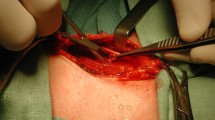Abstract
A modified cryopreservation technique for parathyroid tissue was investigated in an animal model. The modified technique was compared with a previously described method [10, 11] using a programmed freezer and also with other simplified cryopreservation techniques [1, 8]. Total parathyroidectomy was performed in 90 Sprague-Dawley rats, which were allocated to 7 groups. Group I had no autotransplantation (n=10) and group II underwent immediate autotransplantation of one parathyroid gland (n=17). In the other five groups of rats the parathyroids were cryopreserved and one gland was reimplanted after 10 days' storage in liquid nitrogen (LN) at −196°C. The following techniques for cryopreservation of the parathyroid glands were used. Group III: immediate placement in LN, n=7; group IV: immediate placement in a freezer at −20 °C, transfer to LN after 2 h, n=12; group V: immediate placement in a freezer at −80 °C, transfer to LN after 2 h, n=13, group VI: manually controlled freezing initially at a rate of 1 °C/min to −25 °C, and subsequently at 10 °C/min to −70°C before transfer to LN [8], n=19, group VII: programmed freezing at a controlled rate of 1 °C/min to −80 °C prior to transfer to LN [10, 11], n=12. Serum calcium concentrations were determined over a period of 60 days. Furthermore, the individual difference in the calcium concentration was assessed for each rat ou the basis of the calcium levels recorded preoperatively and at day 60. By 60 days after immediate autotransplantation (group II), in 15 out of 17 rats (88%) serum calcium concentrations had returned to normal values. Serum calcium had normalized by day 60 in 1 out of 7 rats (14%) in group III, 6 out of 12 rats (50%) in group IV, 7 out of 13 rats (54%) in group V, 4 out of 19 rats (21%) in group VI, 7 out of 12 rats (58%) in group VII, and in none of the 10 rats without autotransplantation (group I). In group II median calcium concentrations of 2.35 mmol/l and 2.32 mmol/l were determined preoperatively and ou day 60, respectively. The median value of 0.02 mmol/l estimated for the individual calcium differences was not statistically significant. After cryopreservation the median individual calcium concentration difference was smallest in group IV at 0.14 mmol/l (median calcium level: 2.35 mmol/l preoperatively, 2.23 mmol/l day 60). After programmed freezing the median difference was 0.28 mmol/l (median calcium level: 2.48 mmol/l preoperatively, 2.25 mmol/l day 60), 0.92 mmol/l in group I, 0.72 mmol/l in group III, 0.23 mmol/l in group V and 0.39 mmol/l in group VI. In the present experimental study, rat parathyroid glands were successfully autografted after cryopreservation using the described modified technique of freezing the glands by immediate placement in a freezer at -20 °C and transfer to LN after 2 h. The results were comparable to those obtained after controlled freezing in a programmed freezer and superior to results reported for simplified cryopreservation techniques. The suitability of this technique for human parathyroid tissue will be evaluated in a further study.
Zusammenfassung
Es wurde eine modifizierte Technik der Kryopräservierung von Nebenschilddrusengewebe experimentell an Ratten erprobt and mit der programmgesteuerten Kältekonservierung sowie alternativen Techniken verglichen. Nach totaler Parathyreoidektomie erfolgten eine alleinige Verlaufsbeobachtung, die sofortige Replantation eines Epithelkörperchens sowie die Replantation je eines unterschiedlich kältekonservierten Epithelkörperchens nach l0tägiger Lagerung in flüssigem Stickstoff. Während einer 60tägigen Verlaufsbeobachtung erfolgten Serumkalziumanalysen, und für jedes Tier wurden individuelle Kalziumdifferenzen aus seinen präoperativen und im Studienverlauf gemessenen Kalziumspiegeln er-rechnet. 60 Tage nach sofortiger Autotransplantation lag das Serumkalzium bei 15 von 17 Tieren (88%) im Normbereich, und die ermittelte mediane Kalziumdifferenz von 0,02 mmol/l war statistisch nicht signifikant. Nach programmierter Kältekonservierung bzw. Einfrieren bei −20°C Umgebungstemperatur normalisierten sich die Serumkalziumspiegel bei 7 von 12 (58%) bzw. 6 von 12 Tieren (50%), und die mediane Kalziumdifferenz betrug 0,28 mmol/l bzw. 0,14 mmol/l. Manuelle Kältekonservierung sowie Einfrieren bei −80°C Umgebungstemperatur ergaben Kalziumnormalisierungen bei 4 von 19 Tieren (21%) bzw. 7 von 13 Tieren (54%) sowie mediane Kalziumdifferenzen von 0,39 mmol/l bzw. 0,23 mmol/1. Durch die von uns modifizierte Kryopräservierung von Nebenschilddrüsengewebe (Einfrieren bei −20°C Umgebungstemperatur) wurde tierexperimentell ein der programmierten Kältekonservierung vergleichbares funktionelles Resultat erzielt.
Similar content being viewed by others
Literatur
Basile C, Lacour B, Drüeeke T, Chanard J (1980) Successful parathyroid gland autotransplantation in the rat using a simplified cryopreservation technique. Surgery 88:677–681
Duff C, Largiader F (1986) Kryopreservation von Nebenschilddrüsengewebe: Prüfung einer vereinfachten Methode. Langenbecks Arch Chir 367:227–234
Hackensellner HA, Matthes G (1980) Stand und Probleme der Kryokonservierung in der Medizin. Dtsch Gesundheitswesen 35:979–987
Halsted WS (1908) Auto- and isotransplantation in dogs of the parathyroid glandules. J Exp Med 11:175–199
Rothmund M (1986) Derzeitiger Stand der Nebenschilddrtisentransplantation. Langenbecks Arch Chir 367:223–225
Russell PS, Wood ML, Gittes RF (1961) Preservation of living tissue in the frozen state. A study using parathyroid tissue. J Surg Res 1:23–31
Wagner PK, Rothmund M (1985) Autotransplantation von käl-tekonserviertem menschlichen Nebenschilddrüsengewebe. Indikation — Technik — Ergebnisse. Chirurg 56:30–35
Wagner PK, Rumpelt HJ, Rothmund M (1986) Vereinfachtes Verfahren der Kältekonservierung von menschlichem Nebenschilddrüsengewebe zur Replantation. Chirurg 57:253–257
Wagner PK, Rothmund M (1990) Langzeitergebnisse nach Replantation von autologem kältekonserviertem Nebenschilddrü-sengewebe. Dtsch Med Wochenschr 115:1863–1867
Wells SA, Christiansen C (1974) The transplanted parathyroid gland: evaluation of cryopreservation and other environmental factors which affect its function. Surgery 75:49–55
Wells SA, Gunnells C, Gutman RA, Shelburne JD, Schneider AB, Sherwood LM (1977) The successful transplantation of frozen parathyroid tissue in man. Surgery 81:86–90
Author information
Authors and Affiliations
Rights and permissions
About this article
Cite this article
Walgenbach, S., Hollbach, J., Schicketanz, K.H. et al. Modifizierte Kältekonservierung von Nebenschilddrüsengewebe. Langenbecks Arch Chir 380, 292–298 (1995). https://doi.org/10.1007/BF00184105
Received:
Issue Date:
DOI: https://doi.org/10.1007/BF00184105




